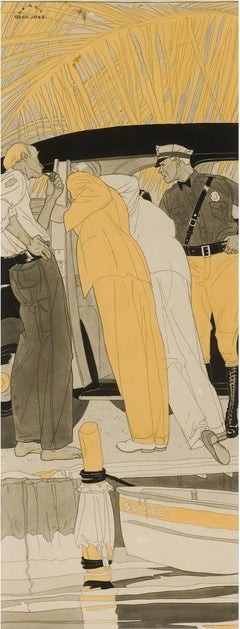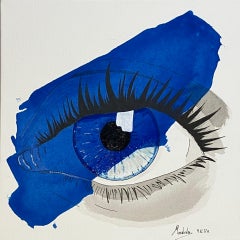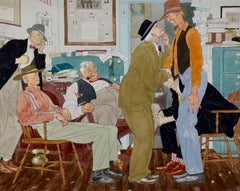Harry Beckhoff Art
to
3
1
3
2
1
Overall Height
to
Overall Width
to
2
2
1
1
1
1
1
1
3
1
1
3
6,886
3,210
2,514
1,217
3
3
1
1
1
Artist: Harry Beckhoff
Searching the Car - Desaturated Colors Muted Warm Yellows and Grey
By Harry Beckhoff
Located in Miami, FL
This Harry Beckhoff illustration is masterfully rendered and intricately designed in line and wash. It's as abstract as it's representational with its graphic style, clean lines, and flat patterning. Every element in the composition works in harmony without a line out of place. The flat and abstract nature of the work rivals that of the great modernist painters of the 1930s.
Perhaps this was done for a major newsstand magazine like Collier's.
Although he studied with Dean Cornwell and Harvey Dunn, he didn't pursue the style of painterly brushstrokes and impastos. Instead, he defined his forms with flat shapes, whose internal forms are defined by thin lines. The emphasis is more on silhouette and line than it is on texture and lighting. Beckhoff also described his work as having been influenced by illustrators like Pierre Brissaud...
Category
1930s Harry Beckhoff Art
Materials
Watercolor, Illustration Board
After the Trip
By Harry Beckhoff
Located in Fort Washington, PA
Medium: Watercolor and Pen and Ink on Paper
Dimensions: 13.75" x 8.88"
Signature: Signed Upper Right
Exhibited:
Masters of the Golden Age: Harvey Dunn and His Students
South Dakota Art Museum, Brookings, South Dakota
May 5, 2015 - September 13, 2015
Norman Rockwell Museum...
Category
Mid-20th Century Harry Beckhoff Art
Materials
Paper, Ink, Watercolor, Pen
Consolation, Collier's magazine illustration
By Harry Beckhoff
Located in Miami, FL
Signed upper left
Category
1940s Academic Harry Beckhoff Art
Materials
Gouache
Related Items
Te ves?
Located in MADRID, ES
Las emociones negativas retienen toda la atención, impidiendo atender otra cosa.
Category
2010s Harry Beckhoff Art
Materials
Ink, Gouache, Pen
The Abduction of the Sabine Women , a Renaissance drawing by Biagio Pupini
Located in PARIS, FR
This vigorous drawing has long been attributed to Polidoro da Caravaggio: The Abduction of the Sabine Women is one of the scenes that Polidoro depicted between 1525 and 1527 on the façade of the Milesi Palazzo in Rome. However, the proximity to another drawing inspired by this same façade, kept at the Ecole des Beaux-Arts, and to other drawings inspired by Polidoro kept at the Musée du Louvre, leads us to propose an attribution to Biagio Pupini, a Bolognese artist whose life remains barely known, despite the abundant number of drawings attributed to him.
1. Biagio Pupini, a Bolognese artist in the light of the Roman Renaissance
The early life of Biagio Pupini, an important figure of the first half of the Cinquecento in Bologna - Vasari mentions him several times - is still poorly known. Neither his date of birth (probably around 1490-1495) nor his training are known. He is said to have been a pupil of Francesco Francia (1450 - 1517) and his name appears for the first time in 1511 in a contract with the painter Bagnacavallo (c. 1484 - 1542) for the frescoes of a church in Faenza. He then collaborated with Girolamo da Carpi, at San Michele in Bosco and at the villa of Belriguardo.
He must have gone to Rome for the first time with Bagnacavallo between 1511 and 1519. There he discovered the art of Raphael, with whom he might have worked, and that of Polidoro da Caravaggio. This first visit, and those that followed, were the occasion for an intense study of ancient and modern art, as illustrated by his abundant graphic production.
Polidoro da Caravaggio had a particular influence on the technique adopted by Pupini. Executed on coloured paper, his drawings generally combine pen, brown ink and wash with abundant highlights of white gouache, as in the drawing presented here.
2. The Abduction of the Sabine Women
Our drawing is an adaptation of a fresco painted between 1525 and 1527 by Polidoro da Caravaggio on the façade of the Milesi Palace in Rome. These painted façades were very famous from the moment they were painted and inspired many artists during their stay in Rome. These frescoes are now very deteriorated and difficult to see, as the palace is in a rather narrow street.
The episode of the abduction of the Sabine women (which appears in the centre of the photo above) is a historical theme that goes back to the origins of Rome and is recounted both by Titus Livius (Ab Urbe condita I,13), by Ovid (Fasti III, 199-228) and by Plutarch (II, Romulus 14-19). After killing his twin brother Romus, Romulus populates the city of Rome by opening it up to refugees and brigands and finds himself with an excess of men. Because of their reputation, none of the inhabitants of the neighbouring cities want to give them their daughters in marriage. The Romans then decide to invite their Sabine neighbours to a great feast during which they slaughter the Sabines and kidnap their daughters.
The engraving made by Giovanni Battista Gallestruzzi (1618 - 1677) around 1656-1658 gives us a good understanding of the Polidoro fresco, allowing us to see how Biagio Pupini reworked the scene to extract this dynamic group.
With a remarkable economy of means, Biagio Pupini takes over the left-hand side of the fresco and depicts in a very dense space two main groups, each consisting of a Roman and a Sabine, completed by a group of three soldiers in the background (which seems to differ quite significantly from Polidoro's composition).
The balance of the drawing is based on a very strongly structured composition. The drawing is organised around a median vertical axis, which runs along both the elbow of the kidnapped Sabine on the left and the foot of her captor, and the two main diagonals, reinforced by four secondary diagonals. This diamond-shaped structure creates an extremely dynamic space, in which centripetal movements (the legs of the Sabine on the right, the arm of the soldier on the back at the top right) and centrifugal movements (the arm of the kidnapper on the left and the legs of the Sabine he is carrying away, the arm of the Sabine on the right) oppose each other, giving the drawing the appearance of a whirlpool around a central point of support situated slightly to the left of the navel of the kidnapper on the right.
3. Polidoro da Caravaggio, and the decorations of Roman palaces
Polidoro da Caravaggio was a paradoxical artist who entered Raphael's (1483 - 1520) workshop at a very young age, when he oversaw the Lodges in the Vatican. Most of his Roman work, which was the peak of his career, has disappeared, as he specialised in facade painting, and yet these paintings, which are eminently visible in urban spaces, have influenced generations of artists who copied them abundantly during their visits to Rome.
Polidoro Caldara was born in Caravaggio around 1495-1500 (the birthplace of Michelangelo Merisi, known as Caravaggio, who was born there in 1571), some forty kilometres east of Milan. According to Vasari, he arrived as a mason on the Vatican's construction site and joined Raphael's workshop around 1517 (at the age of eighteen according to Vasari). This integration would have allowed Polidoro to work not only on the frescoes of the Lodges, but also on some of the frescoes of the Chambers, as well as on the flat of Cardinal Bibiena in the Vatican.
After Raphael's death in 1520, Polidoro worked first with Perin del Vaga before joining forces with Maturino of Florence (1490 - 1528), whom he had also known in Raphael's workshop. Together they specialised in the painting of palace façades. They were to produce some forty façades decorated with grisaille paintings imitating antique bas-reliefs.
The Sack of Rome in 1527, during which his friend Maturino was killed, led Polidoro to flee first to Naples (where he had already stayed in 1523), then to Messina. It was while he was preparing his return to the peninsula that he was murdered by one of his assistants, Tonno Calabrese, in 1543.
In his Vite, Vasari celebrated Polidoro as the greatest façade decorator of his time, noting that "there is no flat, palace, garden or villa in Rome that does not contain a work by Polidoro". Polidoro's facade decorations, most of which have disappeared as they were displayed in the open air, constitute the most important lost chapter of Roman art of the Cinquecento. The few surviving drawings of the painter can, however, give an idea of the original appearance of his murals and show that he was an artist of remarkable and highly original genius.
4. The façade of the Milesi Palace
Giovanni Antonio Milesi, who commissioned this palace, located not far from the Tiber, north of Piazza Navona, was a native of the Bergamo area, like Polidoro, with whom he maintained close friendly ties. Executed in the last years before the Sack of Rome, around 1526-1527, the decoration of Palazzo Milesi is considered Polidoro's greatest decorative success.
An engraving by Ernesto Maccari made at the end of the nineteenth century allows us to understand the general balance of this façade, which was still well preserved at the time. The frescoes were not entirely monochrome, but alternated elements in chiaroscuro simulating marble bas-reliefs and those in ochre simulating bronze and gold vases...
Category
16th Century Old Masters Harry Beckhoff Art
Materials
Ink, Gouache, Pen
Passeggiata a cavallo a Trieste
Located in Roma, RM
Alfredo Tominz (Trieste 1854 – 1936), Passeggiata a cavallo a Trieste
Dipinto ad olio su tela di cm 69 x 110 firmato e datato 1890 in basso a destra.
Provenienza: Asta Stadion Trie...
Category
Late 19th Century Academic Harry Beckhoff Art
Materials
Canvas, Oil
Composition with Two Male Nudes - painting Paula Craioveanu oil on canvas
By Paula Craioveanu
Located in Forest Hills, NY
"Composition with Two Male Nudes", oil and silver leaf on canvas, 35.5x23.5in / 90x60cm
Part of my Male Nude series.
Shipped as it is, stretched, directly from the artist's studio.
Category
2010s Academic Harry Beckhoff Art
Materials
Canvas, Oil
H 35.5 in W 23.5 in D 1 in
View of Capri, Italy
Located in PARIS, FR
August Wilhelm LEU
(Munster, 1819 – Seelisberg, 1897)
View of Capri
Oil on canvas
Signed and dated lower right
49 x 70 cm
1882
Born March 24, 1819 in Munster, Germany, Auguste Leu...
Category
Late 19th Century Academic Harry Beckhoff Art
Materials
Oil
"Elite Workers", Small-Scale Modern Figural Collage w Watercolor by Dick Crispo
By Dick Crispo
Located in Soquel, CA
Modern small-scale watercolor and collage, a mixed media composition featuring a modified photograph with colorful watercolor accents by Dick Crispo (American, b. 1945). Titled "Elite Workers" at the top. Signed and dated "D. Crispo 87" in the lower left corner. Presented in a cream mat with foamcore backing. No frame. Paper size: 10"H x 7"W
Dick Crispo, born in New York City on January 13, 1945, has resided on the Monterey Peninsula since 1955. An award winning artist, Crispo has studied at the Carmel Art Institute under John Cunningham and Sam Colburn...
Category
1980s Contemporary Harry Beckhoff Art
Materials
Paper, Watercolor, Magazine Paper, Photographic Paper, Pen
H 20 in W 16 in D 0.25 in
Colour Based Drawings, Mixed Media on Paper by Artist Sunil Das "In Stock"
By Sunil Das
Located in Kolkata, West Bengal
Sunil Das - Color Based Drawings,
13 x 9.5 inches ( Unframed sizes )
Acrylic, Watercolour, Pen &Ink on Handmade Paper, 2003
( Unframed & Delivered )
Sunil Das (1939-2015) was a Mas...
Category
Early 2000s Modern Harry Beckhoff Art
Materials
Pen, Handmade Paper, Watercolor, Acrylic, Ink
H 13 in W 9.5 in D 1 in
Le pont de Saint Gérmain de Couilly (sur le Grand Morin)
Located in Washington, DC
Exhibited:
Salon, Société des Artistes Français, Paris, 1879 (no. 647)
Category
1870s Academic Harry Beckhoff Art
Materials
Oil, Wood Panel
Echoes 2 - painting Paula Craioveanu oil on canvas
By Paula Craioveanu
Located in Forest Hills, NY
Echoes 2
Composition with Two Female Nudes, oil on canvas, 35.5x19.5in / 90x50cm
Part of WIngs of Gods, solo show.
Shipped as it is, stretched, directly from the artist's studio.
Category
2010s Academic Harry Beckhoff Art
Materials
Canvas, Oil
Sonia Spider Quenell, Watercolor portrait on archive paper.
By Manuel Santelices
Located in Miami Beach, FL
Sonia "Spider" Quenell by Manuel Santelices
Ink pen, watercolor, and gouache
Image size: 11" x 14"
Unframed
2022
Manuel Santelices explores the world of fashion, society, and pop c...
Category
21st Century and Contemporary Contemporary Harry Beckhoff Art
Materials
Ink, Paper, Watercolor, Gouache, Pen
H 11 in W 14 in D 0.1 in
Still life with aquarium
Located in Bayonne, NJ
This oil on canvas painting was executed by Lev Meshberg with his authentic technique where he used wax over canvas to create a texture first and then the paint.
Category
20th Century Academic Harry Beckhoff Art
Materials
Oil
Sophie Holten (1858-1930), the Parthenon Frieze, London 1901
Located in Greding, DE
Painting based on the Peplos scene (Block V, eastern Parthenon frieze, ca. 447-433 BC) by the Danish painter Sophie Holten (1858 Skuldelev - 1930 Rosk...
Category
Early 1900s Academic Harry Beckhoff Art
Materials
Canvas, Oil
Previously Available Items
Men in Newspaper Office
By Harry Beckhoff
Located in Fort Washington, PA
Medium: Ink and Watercolor on Paper
Signature: Signed Lower Right
Category
Mid-20th Century Harry Beckhoff Art
Materials
Paper, Ink, Watercolor
Harry Beckhoff art for sale on 1stDibs.
Find a wide variety of authentic Harry Beckhoff art available for sale on 1stDibs. You can also browse by medium to find art by Harry Beckhoff in paint, watercolor, ink and more. Not every interior allows for large Harry Beckhoff art, so small editions measuring 7 inches across are available. Customers who are interested in this artist might also find the work of Edmund Darch Lewis, Emile Godchaux, and Ferdinand Victor Leon Roybet . Harry Beckhoff art prices can differ depending upon medium, time period and other attributes. On 1stDibs, the price for these items starts at $2,750 and tops out at $12,000, while the average work can sell for $2,900.





